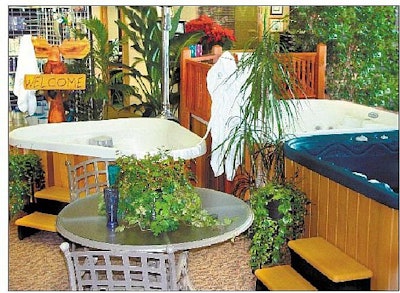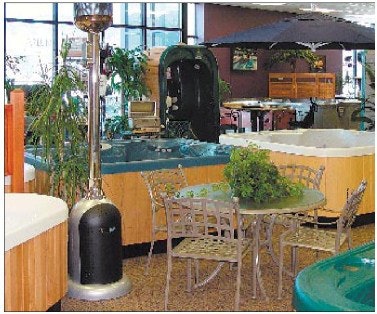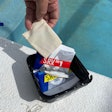
The recreational dream on wheels lit up the showroom: a $50,000 minivan with enough seating to lose a basketball star and enough extra gizmos to keep everyone in the family happily occupied. The parents and their two kids eagerly climbed inside — only to find that the overhead TV had fuzzy reception and the upholstery was garish.
No sale.
When you're selling the recreational dream, you're selling the whole package. For this reason, merchandising spa steps and surrounds in the showroom shouldn't be an afterthought, but a carefully considered component of the overall presentation. Displaying the perfect complementary visual touches and bringing them to life via functional, situational vignettes enhances the overall promise of the spa experience and turns showroom traffic into showroom sales appointments.
"Go into any furniture store and they have complete vignettes, a full living room," says Bill Wells, vice president of retail for Marquis Corp. and Your Back Yard. "And a lot of customers will buy the whole room. We should take a cue from other industries. Well-dressed spas make a better impression than those that stand alone.
"We don't have to reinvent the wheel. But customers want to see the complete dream, not just a part of it."
Selling a concept — an idea, a feeling — isn't done with shortcuts. The truth is that most people just aren't very creative and have a hard time visualizing a concept. "The biggest mistake a lot of retailers make is, they don't display the surrounds and steps for people to see in person," says Don Riling, sales manager and accessories buyer for Olympic Hot Tub Company in Seattle. "Instead, they just show them in the brochures. People need the visuals."
Brochures, catalogs — even sophisticated Web sites — don't show the whole picture. Only in person can the customer get the full effect of a showroom vignette complete with the right lighting, floor covering, accessories and other touches like plants and table settings. And while industry retailers and designers have different approaches to this merchandising, many agree on a basic tenet: All the components must work together to create the overall design.
"The tricky part is getting the right [step or surround] unit to match the hot tub," says Robert Randall, retail sales manager for Tony V's Sunrooms & Spas in Clinton Township, Mich., and a national sales trainer for TEEMO Sunrooms. "They're coming out with surrounds that go with the hot tub, and those will be hot-ticket items."
Meanwhile, Randall says at the 2003 AQUA Show he saw a hole in the market just waiting to be filled. "People will spend another $500 to $700 to deck out their hot tub and make it look sharp: wraparound steps, stools, planters, etc. The problem is that even with the vinyl decking industry, they've limited themselves to almond and white colors — but hot tubs are almost never that color.
"Hot tub companies in general are trying to go with the maintenance-free look of vinyl in steps and surrounds, but there aren't any color matches for the hot tubs themselves. There's a fortune out there waiting to be made."
Of course, one option is for consumers to do the color matching themselves, by purchasing wood steps and surrounds and staining them to complement the color of their spa. Some retailers shy away from that, saying that over time, stains will fade or wear from the elements and use.
Wood advocates stand by their product as the most visually striking in an overall spa presentation. "There is nothing like the beauty of redwood," says Christine Brandon, co-owner of A & B Accessories in West Fork, Ark., a major supplier of steps and surrounds. "We only deal with wood. Yes, it does take a little more care. That's the nature of the product.
"We can actually build custom surrounds to a customer's specs. We also try to provide unstained products; that way customers or retailers can do the staining if they want. There are a lot of plastics out there and a lot of competition. But if, for example, you had two tables side by side for comparison in a dining room set, one made of Formica and the other made of real wood, which would you choose?"
But Mike Genova, president of Leisure Concepts, a spa accessories company based in Spokane, Wash., says, "Wood is passe. You're seeing continued merchandising of plastic steps and it goes beyond an advantages/disadvantages argument. It's simply the trend in our industry.
"If you look at all the spa manufacturers, the leaders have already discontinued the use of wood on steps and surrounds, or they're in the process of doing it. Wood is not the best material in those environments. It requires more work, has more rotting and the supply is volatile. For example, few people will side their house with wood these days because it's not the best material to use. Decking material is also becoming more and more non-wood because it's not a good material to build things from — especially if you're talking about a horizontal surface. It holds water, and it puddles."
Genova says there are many more advantages to plastic than simple ease of maintenance. "It matches what most spas are made of and makes more sense from a consumer's standpoint. That is not subjective. It's a better material. Also, the supply is more consistent with plastic. Wood manufacturers can be stymied in production if they can't get a supply of the right wood."
And, he says, the end-user isn't the only one to benefit from the synthetic's characteristics. "Plastic is also easier for the dealer. The pieces are lighter and ship more cost effectively. Plus, it's easier to install because the pieces snap together."
Some spa manufacturers are helping to make showroom merchandising easier — at the same time offering consumers more choices. Wells notes that Marquis offers six different exterior options and five different cover colors to increase matching possibilities, as well as some matches for the shell and exterior. But he suggests that some become too preoccupied with shell color when it comes to matching with surrounds and everything else.
"Customers get fixated on the color of the shell, but you only see the shell when the spa is in use," he says. "Ninety-eight percent of the time they're seeing the spa with the cover on it. So what's more important — the color of the shell, or the color of the exterior and the cover? How will the color of the exterior and cover fit into the scheme of your backyard? Does it match trim on the home, the landscaping, backyard accessories?"
Some retailers have such aesthetics down to a science. Tammi Stuart, co-owner of Springs Spas & Home Recreation in Colorado Springs, Colo., has developed a keen eye for the nuances of maximizing the display impact, at one point hiring an interior designer.
"Plants on the steps and surrounds soften things," she says. "Remember, you're trying to re-create nature, to bring the outside indoors. When we opened our new showroom, we went with live plants.
"So many times, retailers who need plants will just go to hobby stores to get ficus trees or whatever. But really, you should go to nature stores that specialize in retail.
"Lighting is important. Do you go natural, or do you go fluorescent. It depends on the kind of accent you want, how it all fits together, how you can best focus people to specific areas of the store. The right flooring is important, too; you want to make sure the color doesn't fight with the product."
Marquis' Wells agrees that the right details are crucial and the possibilities limitless. "Arranging the spas in vignettes with proper lighting, plants and matching accessories are all important components of a proper display," he says. "Some of our dealers take things to a whole new level by actually creating a backyard scene complete with mock home exteriors, decking, rock formations, fake snow, etc.
"We must remember that we are not selling spas. We are selling a lifestyle dream and must be able to make it come true in reality for our customers."
Wells says Marquis has in-house designers charged with this responsibility, as do many companies. But Stuart says retailers shouldn't rule out the possibility of looking into design firms to help with the overall presentation. "If you don't have a knack for it, hire someone," she says. "You can also negotiate it."
Stuart was pleased with the work of Lynn Ellen Braley, owner of IRIS (Interior Resources in Style) in Colorado Springs. The two generally agreed on the concept of maximizing space while keeping it organized and pleasing to the eye.
"One goal is to put as many items per square footage without overdoing it," says Braley, a nationally certified member of the American Society of Interior Design. "You don't want the space to look crowded. For example, we would put a sauna on the backside of a hot tub to create two vignettes."
As with retailers, color is a key consideration for Braley. "There are a lot of factors — the color of the product line, the entire color palette, the color of the marketing materials. They all have to meld together appropriately.
"Issues come up. For example, at U.S. Spas, their logo is red, white and blue, but the products and steps and surrounds may be tan, gray and taupe. So what do you do. How do you make that all meld together? How much product can you show?
"Even your chemical sections for the spas often have different color palettes. Sometimes the color of the packaging on the chemical products can be a problem in terms of fitting in."
Braley is also a big proponent of plants in any environment. "They're a big thing in terms of stopping the eyes and sparking a curiosity as to what's behind it."
What if hiring a designer doesn't jibe with your budget or tastes. "Visit other showrooms," Stuart says. "It's great if the product offering is similar to yours, but it doesn't have to be. Visit other spa companies, but if you really want your showroom to stand out, don't stop there. Merchandising ideas can be found in the showrooms of hearth-product dealers, in-ground pool companies, decking companies, landscapers and home and garden stores.
"Take tips from furniture companies and home builders; many are masters at creating effective vignettes. The goal of a great showroom is to whet the consumer's appetite, to allow them to experience the products and get conceptual ideas of what they can do that they haven't seen anywhere else."
And don't forget the trade shows: AQUA, Global Shop, the International Pool & Spa Show, Atlantic City, even the Billiard Congress of America. These all provide information, ideas and seminars, along with hundreds of well-merchandised displays — some of which cross the plastic and wood boundaries into materials including stucco and faux stone. "The local bookstore can also be a great source of information for designers on a budget," Stuart says. "There are an abundance of decorating magazines and books on the subject."
One last tip: In their effort to provide the most visually striking spa setting, retailers shouldn't overlook functionality and convenience. Side bar units are a great vignette possibility "because sometimes people want to hang out with you but they don't want to go into the water," Tony V's Randall says. And the storage space available in many steps and benches should be part of any display, with other amenities like cup holders in plain sight.
Sometimes, trial and error is the only way to arrive at the right look. Wells says he has an advantage in that respect: "What we do is use our own retail stores like a testing and proving grounds for our products and merchandising materials before rolling them out to our dealer network."
Regardless of the resources at hand, "there's something for every taste, every budget," Stuart says. "Sometimes you have to experiment. But if you're open-minded, you'll find there are a lot of ways to sell the dream."








































